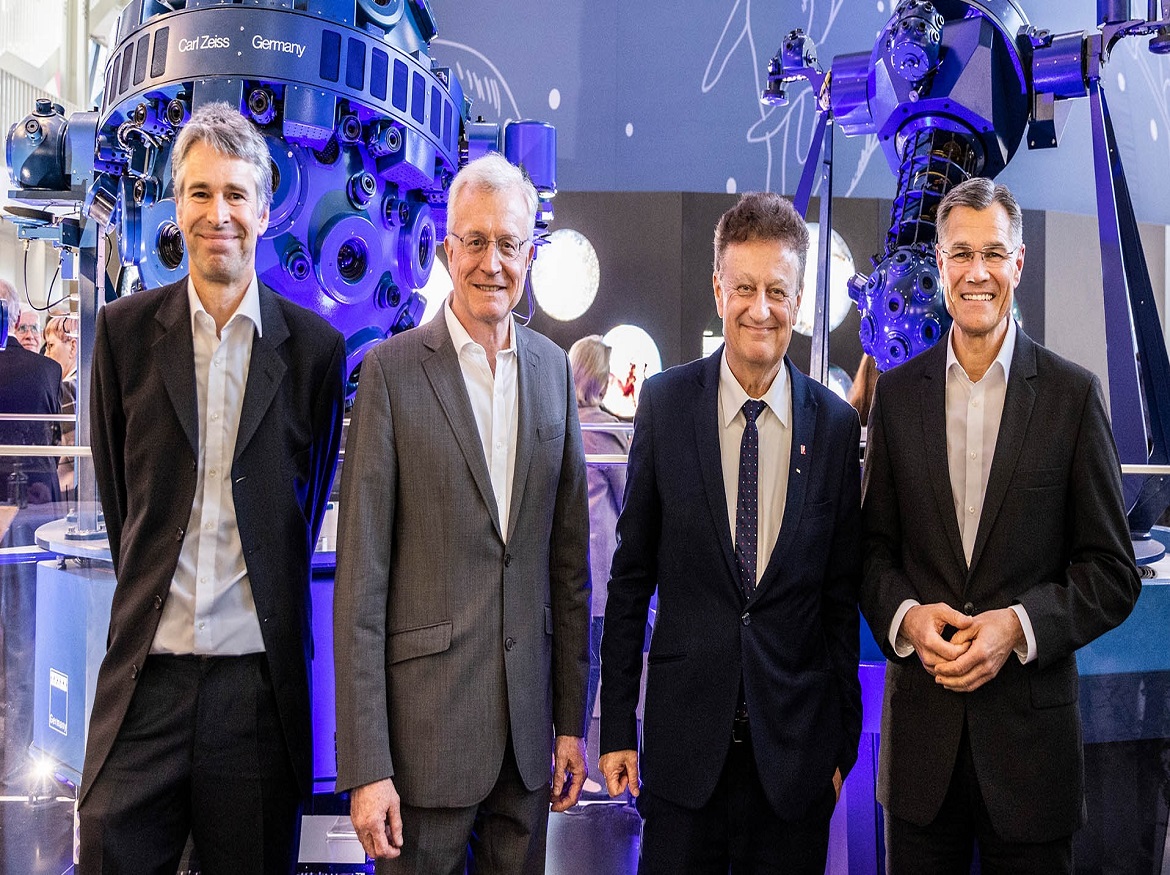The Deutsches Museum in Munich is displaying the intriguing history of planetariums in a unique exhibition with the same name to commemorate the celebration of the ‘Centenary of the Planetarium’. The Model I projector, which ZEISS handed to the Deutsches Museum on October 21, 1923, is among the historical projectors in the exhibition. Today, this day is recognized as the beginning of the contemporary planetarium.
Yesterday evening, following a meeting of the Board of Trustees, Prof. Dr. Wolfgang M. Heckl, General Director of the Deutsches Museum, Dr. Karl Lamprecht, CEO of the ZEISS Group, and Prof. Dr. Thomas W. Kraupe, former President of the International Planetarium Society, gave a ceremonial lecture titled “For what is inside is outside” to officially inaugurate the special exhibition, which ZEISS supported technically and logistically. The display, which runs from May 5, 2023, through January 28, 2024, includes a mobile dome where visitors can watch modern planetarium performances in addition to the vintage projectors.
The idea of rotating star sphere
According to Dr. Christian Sicka, Curator of Astronomy at the Deutsches Museum in Munich, “Oskar von Miller, founder of the Deutsches Museum in Munich, had the idea for an apparatus that would make the movements of the sun, moon, and planets visible at the same time as those of the stars and asked ZEISS about manufacturing a ‘rotating star sphere’ in 1913.
“We are aware that on February 24, 1914, there was a conference in Jena between officials of the corporation and the Deutsches Museum. Dr. Walther Bauersfeld of ZEISS proposed the concept of displaying the sun, moon, and planets after they discussed the convoluted mechanics. The stars should therefore also be projected, according to his colleague Professor Rudolf Straubel, Sicka continues. Therefore, the concept for the projection planetarium sort of came to them on their own during a brainstorming session.
In March 1919, Bauersfeld unveiled a design for a planetarium based on optical-mechanical light projection after World War I halted this progress. Then he and his group started to work on developing the specifics. The first illumination of the artificial sky took place on October 21, 1923, according to Sicka. He claims that because expectations were significantly surpassed at the time of completion, the apparatus was permanently placed in 1925 and unveiled to the public as the world’s first planetarium on May 7, 1925, in conjunction with the opening of the Deutsches Museum in Munich. 4500 stars shone in the dome thanks to the first ZEISS projector. More than 8.5 million people have visited the planetarium in the Deutsches Museum thanks to it and its replacements, the Model IV, Model 1015, and the ZEISS SKYMASTER ZKP 4, with most current numbers hovering around 80,000 per year. The Deutsches Museum’s planetarium is presently undergoing renovations. The building’s refurbishment is expected to be finished in 2028, the 125th year since the museum’s founding.
Journeys into space
The particular exhibition allows interested visitors to observe the evolution of star projectors since 1923. Dr. Karl Lamprecht, CEO of ZEISS, claims that modern planetariums provide “so much more than just a view of the stars.” They are locations where space may be experienced, in part because of our ground-breaking planetarium equipment. Both adults and children can practically travel the entire cosmos. Thus, planetariums broaden perspectives and inspire interest in science and technology. They accomplish this in a special way to blend science, art, culture, and education.
In the most advanced planetariums in the world, the combination of a traditional optical-mechanical star projector and a digital video projector is already the norm. The first projector in the world designed specifically for celestial visualizations in planetariums, the ZEISS VELVET LED projector combines maximum sharpness, vibrant colors, and the highest contrast possible. The digital projector creates a background with an entirely black image so that the night sky is not lit by the grey background.
Almost every country in the world currently has over 3000 planetarium installations, 700 of which have ZEISS technology installed. Planetariums with the brand ZEISS go hand in hand. Star Theatres, which present intriguing full-dome shows now as contemporary, high-tech domes, continue to draw large crowds. A planetarium has reportedly been visited by more than one billion individuals, making the milestone even more significant for the business.
Anniversary with many activities
With the help of the Carl Zeiss Foundation, the International Planetarium Society (IPS), and the Society of German-speaking Planetariums e. V. (GDP) will commemorate the centennial with planetariums all across the world between October 21, 2023, and May 7, 2025. There are many activities and events planned for the two anniversary years, including two new planetarium presentations and a book project. On October 21, 2023, there will be a formal ribbon-cutting event at the Zeiss Planetarium in Jena and the Deutsches Museum in Munich. German President Frank-Walter Steinmeier is the event’s patron. The anniversary’s official website, https://planetarium100.org, has more details available.
Click on the following link Metrologically Speaking to read more such news about the Metrology Industry.









